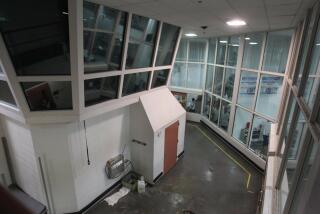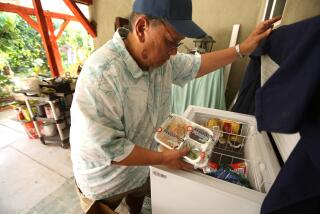Don’t Pull Feeding Tubes From Dying, State Advises
- Share via
SACRAMENTO — The state Department of Aging has been quietly advising nursing homes and families to reject doctors’ orders to pull out tubes that provide water and nutrition to unconscious dying patients, according to an internal memo obtained by The Times.
Doctors have given such orders more freely since a 1983 California appellate court said the “benefits and burdens” of feeding devices ought to be evaluated in the same manner as other medical procedures.
Citing other court decisions as well as arguments against the euthanasia practiced in Nazi Germany, Department of Aging attorney Jonathan Lew argued in a May 30 memo that in every case, nursing homes must keep tubing in place unless they get an explicit court order to remove it.
Lew contends that the 1983 appellate case, which involved removal of an intravenous feeding device, does not cover cases in which food and water are delivered through a tube inserted through the nose, the method most commonly used for feeding chronically ill, deteriorating patients.
The opinion was written in response to a flurry of inquiries to the department on whether nursing homes could legally remove these nasogastric tubes.
Statute and court opinions outline the kind of procedures that must be followed by doctors and families when the decision is made to stop artificial life-sustaining medical treatment. Such decisions are regularly made without going to court.
Lew argued in his memo, however, that providing food and water through a nasogastric tube is not an artificial life-sustaining treatment. Removing a nasogastric tube results in death from dehydration and starvation and is not “natural or humane,” he said.
Such a feeding tube was used to keep a comatose Karen Anne Quinlan alive for nine years after the courts allowed doctors to disconnect her respirator. In that landmark case, physicians heeded the Quinlan family’s decision to continue to provide the unconscious woman with food and water until her death June 11 from pneumonia.
In the week between May 17 and May 23, the department’s ombudsman office received four requests for advice on the legality of removing such a tube, a step that assures the death of the patient. “The number of such cases is rising, with perhaps the majority occurring without notice to any public agency,” Lew wrote.
Attorneys in the Deukmejian Administration will consider on Monday whether Lew’s position should become official policy for the state agencies that play a role in regulating hospitals and nursing homes.
‘Difficult and Complex’
Jerry Wenker, a Department of Aging spokesman, described Lew’s memo as a “talking paper” that is not the official position of either the department or the state Health and Welfare Agency. But he confirmed that the paper does describe the position that the department has been taking when asked for advice on what he described as a “difficult and complex issue.” The legal position, which Lew’s memo described as “conservative,” is almost certain to be contested by the medical community.
To the extent that Lew’s advice is conveyed to health care providers, it could have the effect of ending the practice of removing the tubing from terminal unconscious patients, said Jay Hartz, a Los Angeles attorney representing a nursing home industry group, the California Assn. of Health Facilities.
“They’re saying, if you go ahead (with an order to remove a nasogastric tube), you do it at your peril,” Hartz said. “I think it would have a significant impact on the treatment of patients in nursing homes.”
The California Medical Assn. regards the use of a nasogastric tube as an artificial means of sustaining life. As such it is among the medical procedures that may be discontinued legally by a doctor with the consent of the family of an unconscious dying patient, said Dr. Gladden Elliott, president-elect of the California Medical Assn.
‘Prolonging Dying’
“If a patient were, for instance, totally comatose, and has through the best of prognostic methods no chance for regaining meaningful life, there is little or no justification for the use of nasogastric feeding,” said Elliott, who last year headed the association’s committee that considered this and other medical-ethical issues. “This is truly prolonging dying.”
Elliott said that in no instance would such a step be taken against the wishes of a patient or family. If doubts exist about the potential for recovery, association guidelines require physicians to seek a second opinion.
Elliott said he believes that “someone (in the Department of Aging) must have a feeling that life is being interrupted at a nurse’s or doctor’s whim.
“If that happens, it has to be rare,” Elliott said. “The problem, if anything, is the other way. There is a sort of built-in motor that keeps physicians and nurses performing to prevent the loss of life whatever the cost.”
The medical association thought that the issue of when life-sustaining treatment could be stopped was settled in 1983, when the state 2nd District Court of Appeal threw out murder charges against two Los Angeles area physicians.
IV Lines Removed
The doctors had ordered the removal of intravenous lines--tubes that carry fluids directly into veins--from a patient who was thought to have slipped into an irreversible coma.
The court held, “A physician has no duty to continue treatment, once it has proved to be ineffective.” The opinion also noted: “Medical nutrition and hydration may not always provide net benefits to patients. . . . Their benefits and burdens ought to be evaluated in the same manner as any other medical procedure.”
Lew has argued that the Los Angeles case does not settle all questions connected with the removal of nasogastric feeding tubes.
In his support, Lew quoted a nursing home association bulletin that concludes that it may be legally permissible to withdraw a feeding tube but that doing so “remains the most high-risk of the life-support issues. A conservative approach is warranted until the law is further clarified.”
More to Read
Get the L.A. Times Politics newsletter
Deeply reported insights into legislation, politics and policy from Sacramento, Washington and beyond. In your inbox twice per week.
You may occasionally receive promotional content from the Los Angeles Times.










